Novel Microfluidic Septum to Optimize Energy Recovery in Single-Chamber Microbial Fuel Cells
Abstract
:1. Introduction
2. Materials and Methods
2.1. Design and Fabrication of a-SCMFCs
2.2. a-SCMFC Acclimation and Start-Up
2.3. Time Schedule of Experimental Activity
- The first phase coincided with the inoculation period, which allowed for the initial formation of the biofilm at the anode electrode [41,42]. During this first phase, the monitoring of the biofilm formation on the anode surface took place under a 470 Ω external load, which was shown to be suitable for the induction of the biofilm formation [31,38]. At the end of this phase, to directly evaluate the overall devices’ performances, the external load was raised to 1 kΩ.
- The second phase corresponded with a standard working period spanning over several months. This phase began with a start-up period, during which, a-SCMFCs transitioned to a standard 12 mM sodium acetate electrolyte medium. Throughout this working phase, it was possible to observe the stabilization of the a-SCMFCs’ electrical output performance and assess how this varied over time.
- The third phase consisted of a perturbation phase, during which, the concentration of sodium acetate dissolved in the electrolyte medium was systematically reduced. To this end, the electrical output performances of the IMS and control cells were compared while performing multiple refills at decreasing fixed concentrations of sodium acetate (12 mM, 8 mM, 4 mM, 2 mM), and then once again providing the standard concentration (12 mM) to verify the consistency of the results.
2.4. Electrical and Electrochemical Characterizations
3. Results
3.1. Inoculation Phase and Start-Up
3.2. Working Phase on Standard Sodium Acetate Electrolyte
3.3. Perturbation Phase with Variable Sodium Acetate Concentration
3.4. Electrochemical Characterizations
4. Discussion
5. Conclusions
Author Contributions
Funding
Institutional Review Board Statement
Informed Consent Statement
Data Availability Statement
Conflicts of Interest
References
- Yang, E.; Omar Mohamed, H.; Park, S.-G.; Obaid, M.; Al-Qaradawi, S.Y.; Castaño, P.; Chon, K.; Chae, K.-J. A Review on Self-Sustainable Microbial Electrolysis Cells for Electro-Biohydrogen Production via Coupling with Carbon-Neutral Renewable Energy Technologies. Bioresour. Technol. 2021, 320, 124363. [Google Scholar] [CrossRef] [PubMed]
- Escapa, A.; Mateos, R.; Martínez, E.J.; Blanes, J. Microbial Electrolysis Cells: An Emerging Technology for Wastewater Treatment and Energy Recovery. From Laboratory to Pilot Plant and Beyond. Renew. Sustain. Energy Rev. 2016, 55, 942–956. [Google Scholar] [CrossRef]
- Lu, L.; Ren, Z.J. Microbial Electrolysis Cells for Waste Biorefinery: A State of the Art Review. Bioresour. Technol. 2016, 215, 254–264. [Google Scholar] [CrossRef] [PubMed]
- Santoro, C.; Arbizzani, C.; Erable, B.; Ieropoulos, I. Microbial Fuel Cells: From Fundamentals to Applications. A Review. J. Power Sources 2017, 356, 225–244. [Google Scholar] [CrossRef] [PubMed]
- Gude, V.G. Wastewater Treatment in Microbial Fuel Cells—An Overview. J. Clean. Prod. 2016, 122, 287–307. [Google Scholar] [CrossRef]
- Logan, B.E. Microbial Fuel Cells; Wiley-Interscience: Hoboken, NJ, USA, 2008; ISBN 978-0-470-23948-3. [Google Scholar]
- Dessì, P.; Rovira-Alsina, L.; Sánchez, C.; Dinesh, G.K.; Tong, W.; Chatterjee, P.; Tedesco, M.; Farràs, P.; Hamelers, H.M.V.; Puig, S. Microbial Electrosynthesis: Towards Sustainable Biorefineries for Production of Green Chemicals from CO2 Emissions. Biotechnol. Adv. 2021, 46, 107675. [Google Scholar] [CrossRef]
- Quraishi, M.; Wani, K.; Pandit, S.; Gupta, P.K.; Rai, A.K.; Lahiri, D.; Jadhav, D.A.; Ray, R.R.; Jung, S.P.; Thakur, V.K.; et al. Valorisation of CO2 into Value-Added Products via Microbial Electrosynthesis (MES) and Electro-Fermentation Technology. Fermentation 2021, 7, 291. [Google Scholar] [CrossRef]
- Rabaey, K.; Rozendal, R.A. Microbial Electrosynthesis—Revisiting the Electrical Route for Microbial Production. Nat. Rev. Microbiol. 2010, 8, 706–716. [Google Scholar] [CrossRef]
- Kelly, P.T.; He, Z. Nutrients Removal and Recovery in Bioelectrochemical Systems: A Review. Bioresour. Technol. 2014, 153, 351–360. [Google Scholar] [CrossRef]
- Aiyer, K.S. How Does Electron Transfer Occur in Microbial Fuel Cells? World J. Microbiol. Biotechnol. 2020, 36, 19. [Google Scholar] [CrossRef]
- Prathiba, S.; Kumar, P.S.; Vo, D.-V.N. Recent Advancements in Microbial Fuel Cells: A Review on Its Electron Transfer Mechanisms, Microbial Community, Types of Substrates and Design for Bio-Electrochemical Treatment. Chemosphere 2022, 286, 131856. [Google Scholar] [CrossRef]
- Priya, A.K.; Subha, C.; Kumar, P.S.; Suresh, R.; Rajendran, S.; Vasseghian, Y.; Soto-Moscoso, M. Advancements on Sustainable Microbial Fuel Cells and Their Future Prospects: A Review. Environ. Res. 2022, 210, 112930. [Google Scholar] [CrossRef] [PubMed]
- Boas, J.V.; Oliveira, V.B.; Simões, M.; Pinto, A.M.F.R. Review on Microbial Fuel Cells Applications, Developments and Costs. J. Environ. Manag. 2022, 307, 114525. [Google Scholar] [CrossRef]
- Palanisamy, G.; Jung, H.-Y.; Sadhasivam, T.; Kurkuri, M.D.; Kim, S.C.; Roh, S.-H. A Comprehensive Review on Microbial Fuel Cell Technologies: Processes, Utilization, and Advanced Developments in Electrodes and Membranes. J. Clean. Prod. 2019, 221, 598–621. [Google Scholar] [CrossRef]
- Khan, M.E.; Khan, M.M.; Min, B.-K.; Cho, M.H. Microbial Fuel Cell Assisted Band Gap Narrowed TiO2 for Visible Light-Induced Photocatalytic Activities and Power Generation. Sci. Rep. 2018, 8, 1723. [Google Scholar] [CrossRef] [PubMed]
- Mohammad, A.; Karim, M.R.; Khan, M.E.; AlSukaibi, A.K.D.; Yoon, T. Eco-Benign Fabrication of Silver Nanoparticle-Modified Zeolitic Imidazolate Framework and Construction of a Non-Enzymatic Electrochemical Sensor. Mater. Today Sustain. 2022, 19, 100182. [Google Scholar] [CrossRef]
- Mohammad, A.; Karim, M.R.; Khan, M.E.; Khan, M.M.; Cho, M.H. Biofilm-Assisted Fabrication of Ag@SnO2-g-C3N4 Nanostructures for Visible Light-Induced Photocatalysis and Photoelectrochemical Performance. J. Phys. Chem. C 2019, 123, 20936–20948. [Google Scholar] [CrossRef]
- Mathuriya, A.S.; Jadhav, D.A.; Ghangrekar, M.M. Architectural Adaptations of Microbial Fuel Cells. Appl. Microbiol. Biotechnol. 2018, 102, 9419–9432. [Google Scholar] [CrossRef]
- Tamboli, E.; Eswari, J.S. Microbial Fuel Cell Configurations. In Microbial Electrochemical Technology; Elsevier: Amsterdam, The Netherlands, 2019; pp. 407–435. ISBN 978-0-444-64052-9. [Google Scholar]
- Rossi, R.; Logan, B.E. Impact of Reactor Configuration on Pilot-Scale Microbial Fuel Cell Performance. Water Res. 2022, 225, 119179. [Google Scholar] [CrossRef]
- Leong, J.X.; Daud, W.R.W.; Ghasemi, M.; Liew, K.B.; Ismail, M. Ion Exchange Membranes as Separators in Microbial Fuel Cells for Bioenergy Conversion: A Comprehensive Review. Renew. Sustain. Energy Rev. 2013, 28, 575–587. [Google Scholar] [CrossRef]
- Chae, K.-J.; Choi, M.-J.; Kim, K.-Y.; Ajayi, F.F.; Chang, I.-S.; Kim, I.S. Selective Inhibition of Methanogens for the Improvement of Biohydrogen Production in Microbial Electrolysis Cells. Int. J. Hydrogen Energy 2010, 35, 13379–13386. [Google Scholar] [CrossRef]
- Fan, Y.; Han, S.-K.; Liu, H. Improved Performance of CEA Microbial Fuel Cells with Increased Reactor Size. Energy Environ. Sci. 2012, 5, 8273. [Google Scholar] [CrossRef]
- Cheng, S.; Liu, H.; Logan, B.E. Increased Power Generation in a Continuous Flow MFC with Advective Flow through the Porous Anode and Reduced Electrode Spacing. Environ. Sci. Technol. 2006, 40, 2426–2432. [Google Scholar] [CrossRef]
- Kim, J.; Kim, H.; Kim, B.; Yu, J. Computational Fluid Dynamics Analysis in Microbial Fuel Cells with Different Anode Configurations. Water Sci. Technol. 2014, 69, 1447–1452. [Google Scholar] [CrossRef] [PubMed]
- Zhao, L.; Li, J.; Battaglia, F.; He, Z. Investigation of Multiphysics in Tubular Microbial Fuel Cells by Coupled Computational Fluid Dynamics with Multi-Order Butler–Volmer Reactions. Chem. Eng. J. 2016, 296, 377–385. [Google Scholar] [CrossRef]
- Kim, J.R.; Boghani, H.C.; Amini, N.; Aguey-Zinsou, K.-F.; Michie, I.; Dinsdale, R.M.; Guwy, A.J.; Guo, Z.X.; Premier, G.C. Porous Anodes with Helical Flow Pathways in Bioelectrochemical Systems: The Effects of Fluid Dynamics and Operating Regimes. J. Power Sources 2012, 213, 382–390. [Google Scholar] [CrossRef]
- Sangeetha, T.; Li, I.-T.; Lan, T.-H.; Wang, C.-T.; Yan, W.-M. A Fluid Dynamics Perspective on the Flow Dependent Performance of Honey Comb Microbial Fuel Cells. Energy 2021, 214, 118928. [Google Scholar] [CrossRef]
- Sobieszuk, P.; Zamojska-Jaroszewicz, A.; Makowski, Ł. Influence of the Operational Parameters on Bioelectricity Generation in Continuous Microbial Fuel Cell, Experimental and Computational Fluid Dynamics Modelling. J. Power Sources 2017, 371, 178–187. [Google Scholar] [CrossRef]
- Quaglio, M.; Massaglia, G.; Vasile, N.; Margaria, V.; Chiodoni, A.; Salvador, G.P.; Marasso, S.L.; Cocuzza, M.; Saracco, G.; Pirri, F.C. A Fluid Dynamics Perspective on Material Selection in Microbial Fuel Cell-Based Biosensors. Int. J. Hydrogen Energy 2019, 44, 4533–4542. [Google Scholar] [CrossRef]
- Massaglia, G.; Gerosa, M.; Agostino, V.; Cingolani, A.; Sacco, A.; Saracco, G.; Margaria, V.; Quaglio, M. Fluid Dynamic Modeling for Microbial Fuel Cell Based Biosensor Optimization. Fuel Cells 2017, 17, 627–634. [Google Scholar] [CrossRef]
- Penteado, E.D.; Fernandez-Marchante, C.M.; Zaiat, M.; Cañizares, P.; Gonzalez, E.R.; Rodrigo, M.A. Energy Recovery from Winery Wastewater Using a Dual Chamber Microbial Fuel Cell. J. Chem. Technol. Biotechnol. 2016, 91, 1802–1808. [Google Scholar] [CrossRef]
- Yang, G.; Wang, J.; Zhang, H.; Jia, H.; Zhang, Y.; Cui, Z.; Gao, F. Maximizing Energy Recovery from Homeostasis in Microbial Fuel Cell by Synergistic Conversion of Short-Chain Volatile Fatty Acid. Bioresour. Technol. Rep. 2019, 7, 100200. [Google Scholar] [CrossRef]
- Capodaglio, A.G.; Molognoni, D.; Dallago, E.; Liberale, A.; Cella, R.; Longoni, P.; Pantaleoni, L. Microbial Fuel Cells for Direct Electrical Energy Recovery from Urban Wastewaters. Sci. World J. 2013, 2013, 634738. [Google Scholar] [CrossRef] [PubMed]
- Massaglia, G.; Frascella, F.; Chiadò, A.; Sacco, A.; Marasso, S.L.; Cocuzza, M.; Pirri, C.F.; Quaglio, M. Electrospun Nanofibers: From Food to Energy by Engineered Electrodes in Microbial Fuel Cells. Nanomaterials 2020, 10, 523. [Google Scholar] [CrossRef] [PubMed]
- Bird, H.; Heidrich, E.S.; Leicester, D.D.; Theodosiou, P. Pilot-Scale Microbial Fuel Cells (MFCs): A Meta-Analysis Study to Inform Full-Scale Design Principles for Optimum Wastewater Treatment. J. Clean. Prod. 2022, 346, 131227. [Google Scholar] [CrossRef]
- Cheng, S.; Liu, H.; Logan, B.E. Power Densities Using Different Cathode Catalysts (Pt and CoTMPP) and Polymer Binders (Nafion and PTFE) in Single Chamber Microbial Fuel Cells. Environ. Sci. Technol. 2006, 40, 364–369. [Google Scholar] [CrossRef] [PubMed]
- Massaglia, G.; Margaria, V.; Fiorentin, M.R.; Pasha, K.; Sacco, A.; Castellino, M.; Chiodoni, A.; Bianco, S.; Pirri, F.C.; Quaglio, M. Nonwoven Mats of N-Doped Carbon Nanofibers as High-Performing Anodes in Microbial Fuel Cells. Mater. Today Energy 2020, 16, 100385. [Google Scholar] [CrossRef]
- Rossi, R.; Logan, B.E. Impact of External Resistance Acclimation on Charge Transfer and Diffusion Resistance in Bench-Scale Microbial Fuel Cells. Bioresour. Technol. 2020, 318, 123921. [Google Scholar] [CrossRef]
- Massaglia, G.; Margaria, V.; Sacco, A.; Tommasi, T.; Pentassuglia, S.; Ahmed, D.; Mo, R.; Pirri, C.F.; Quaglio, M. In Situ Continuous Current Production from Marine Floating Microbial Fuel Cells. Appl. Energy 2018, 230, 78–85. [Google Scholar] [CrossRef]
- Tommasi, T.; Salvador, G.P.; Quaglio, M. New Insights in Microbial Fuel Cells: Novel Solid Phase Anolyte. Sci. Rep. 2016, 6, 29091. [Google Scholar] [CrossRef]
- Spurr, M.W.A.; Yu, E.H.; Scott, K.; Head, I.M. Extending the Dynamic Range of Biochemical Oxygen Demand Sensing with Multi-Stage Microbial Fuel Cells. Environ. Sci. Water Res. Technol. 2018, 4, 2029–2040. [Google Scholar] [CrossRef]
- Wang, H.; Long, X.; Sun, Y.; Wang, D.; Wang, Z.; Meng, H.; Jiang, C.; Dong, W.; Lu, N. Electrochemical Impedance Spectroscopy Applied to Microbial Fuel Cells: A Review. Front. Microbiol. 2022, 13, 973501. [Google Scholar] [CrossRef] [PubMed]
- Agostino, V.; Ahmed, D.; Sacco, A.; Margaria, V.; Armato, C.; Quaglio, M. Electrochemical Analysis of Microbial Fuel Cells Based on Enriched Biofilm Communities from Freshwater Sediment. Electrochimica Acta 2017, 237, 133–143. [Google Scholar] [CrossRef]
- Park, S.-G.; Rhee, C.; Jadhav, D.A.; Eisa, T.; Al-Mayyahi, R.B.; Shin, S.G.; Abdelkareem, M.A.; Chae, K.-J. Tailoring a Highly Conductive and Super-Hydrophilic Electrode for Biocatalytic Performance of Microbial Electrolysis Cells. Sci. Total Environ. 2023, 856, 159105. [Google Scholar] [CrossRef] [PubMed]
- Hidalgo, D.; Sacco, A.; Hernández, S.; Tommasi, T. Electrochemical and Impedance Characterization of Microbial Fuel Cells Based on 2D and 3D Anodic Electrodes Working with Seawater Microorganisms under Continuous Operation. Bioresour. Technol. 2015, 195, 139–146. [Google Scholar] [CrossRef]
- Qiu, S.; Wang, L.; Zhang, Y.; Yu, Y. Microbial Fuel Cell-Based Biosensor for Simultaneous Test of Sodium Acetate and Glucose in a Mixed Solution. Int. J. Environ. Res. Public Health 2022, 19, 12297. [Google Scholar] [CrossRef] [PubMed]
- Khater, D.Z.; El-Khatib, K.M.; Hassan, H.M. Microbial Diversity Structure in Acetate Single Chamber Microbial Fuel Cell for Electricity Generation. J. Genet. Eng. Biotechnol. 2017, 15, 127–137. [Google Scholar] [CrossRef]
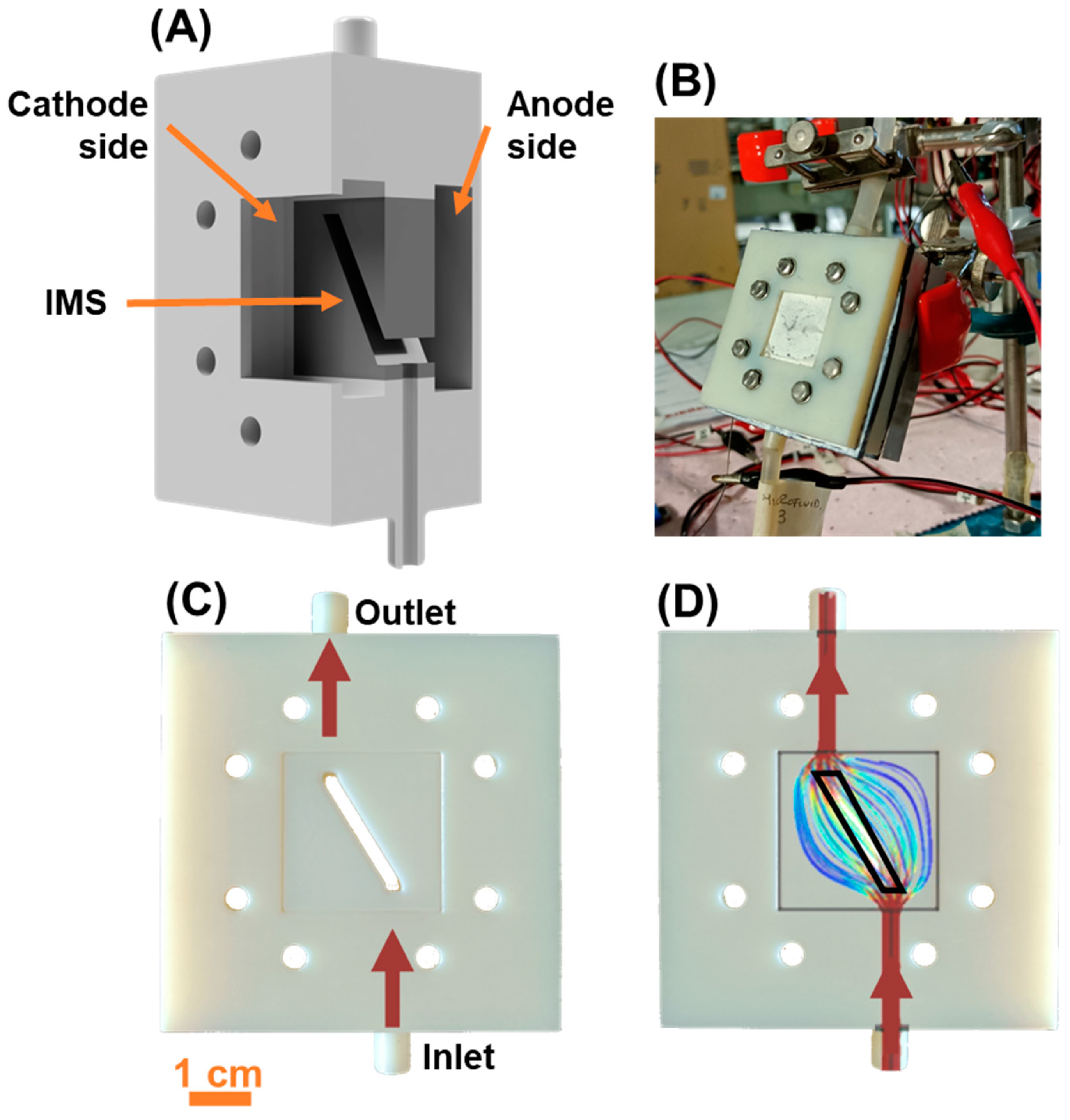
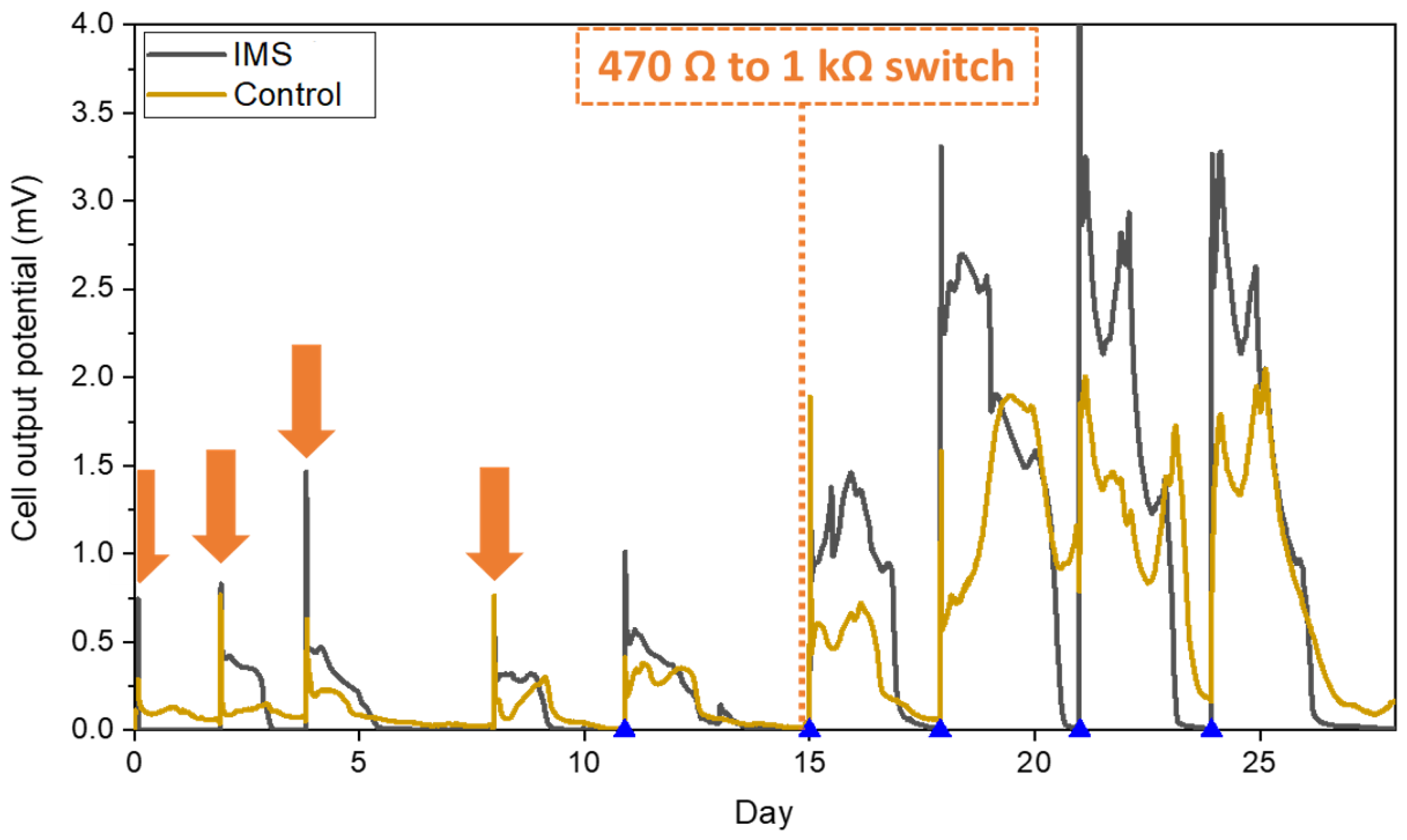
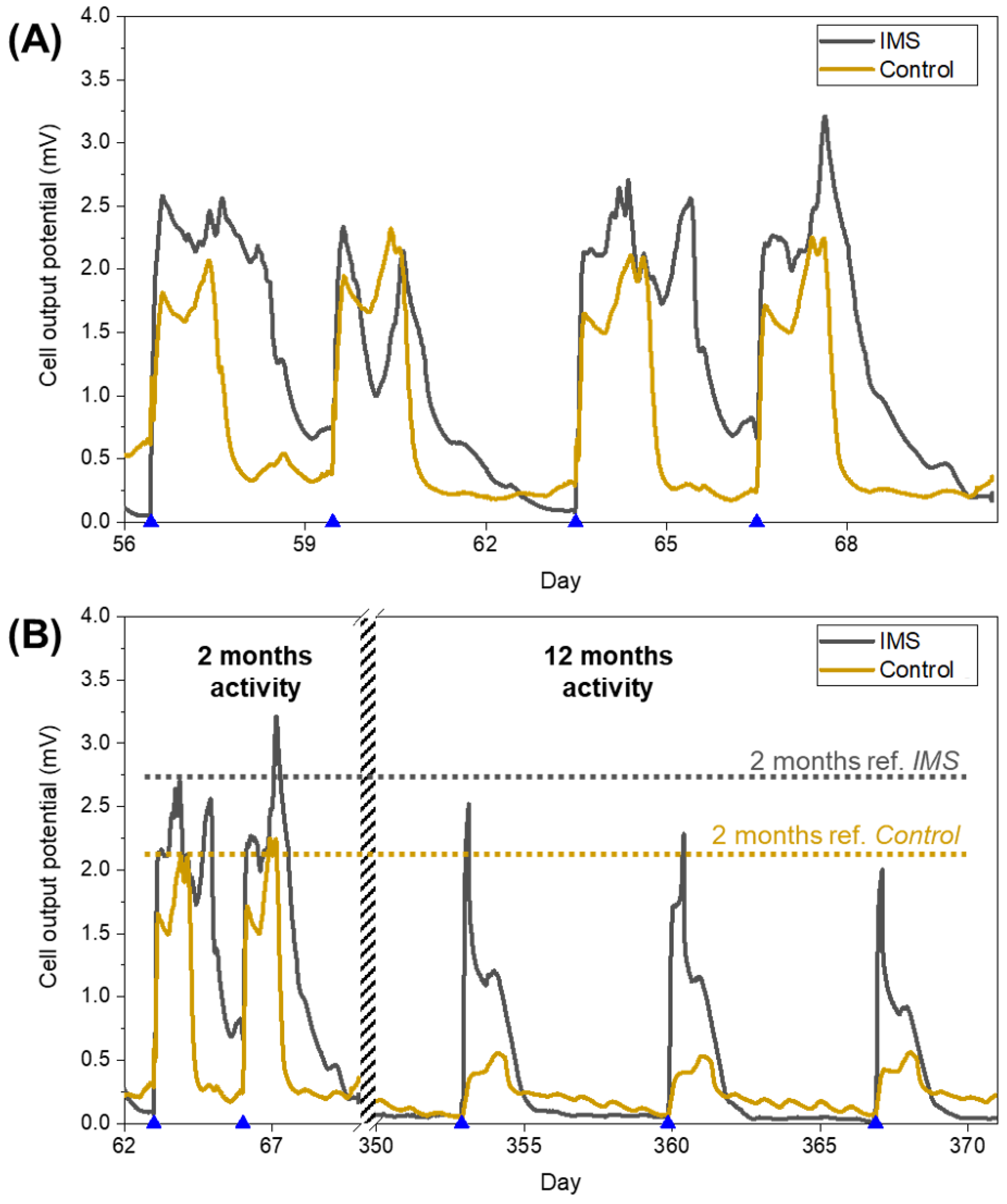
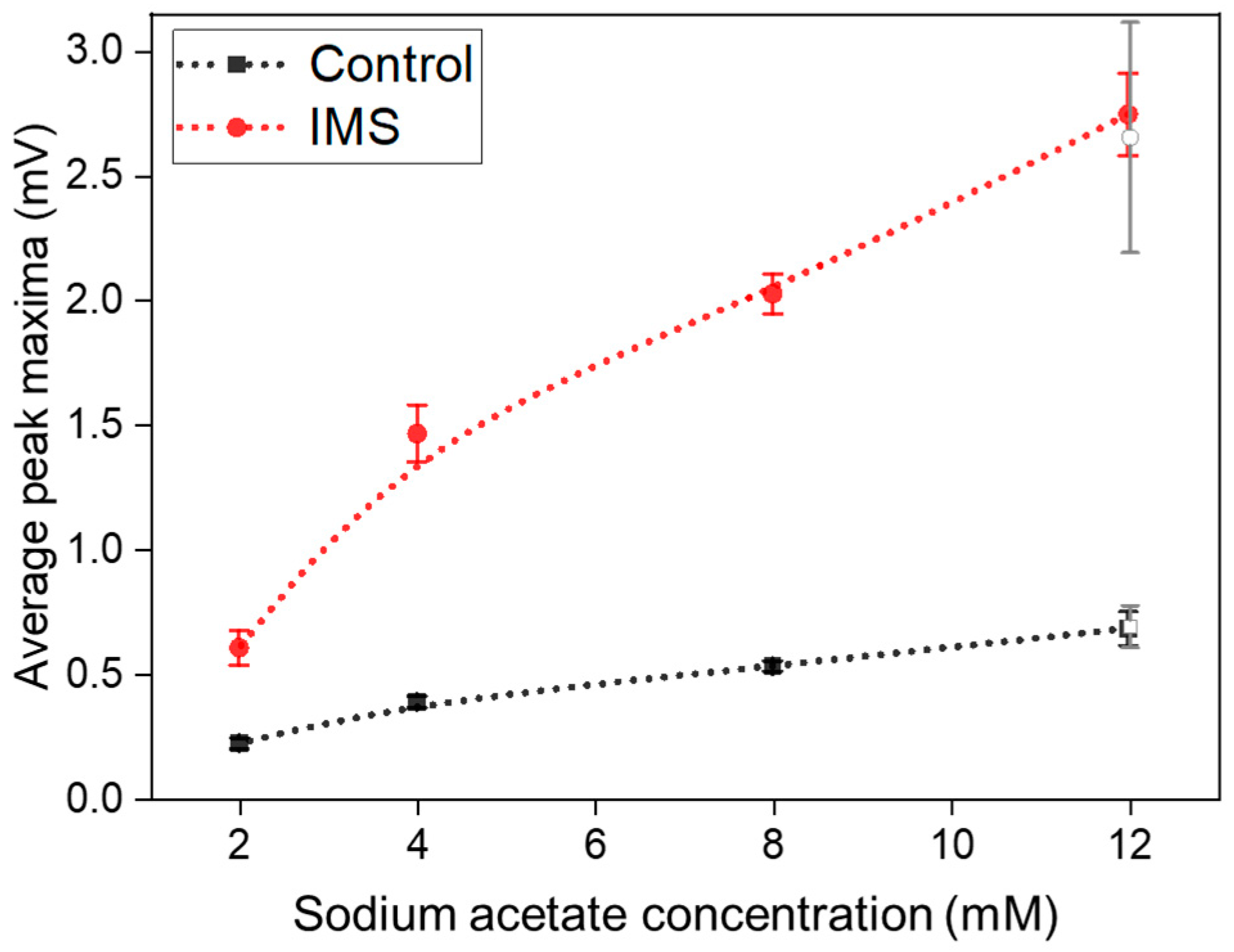
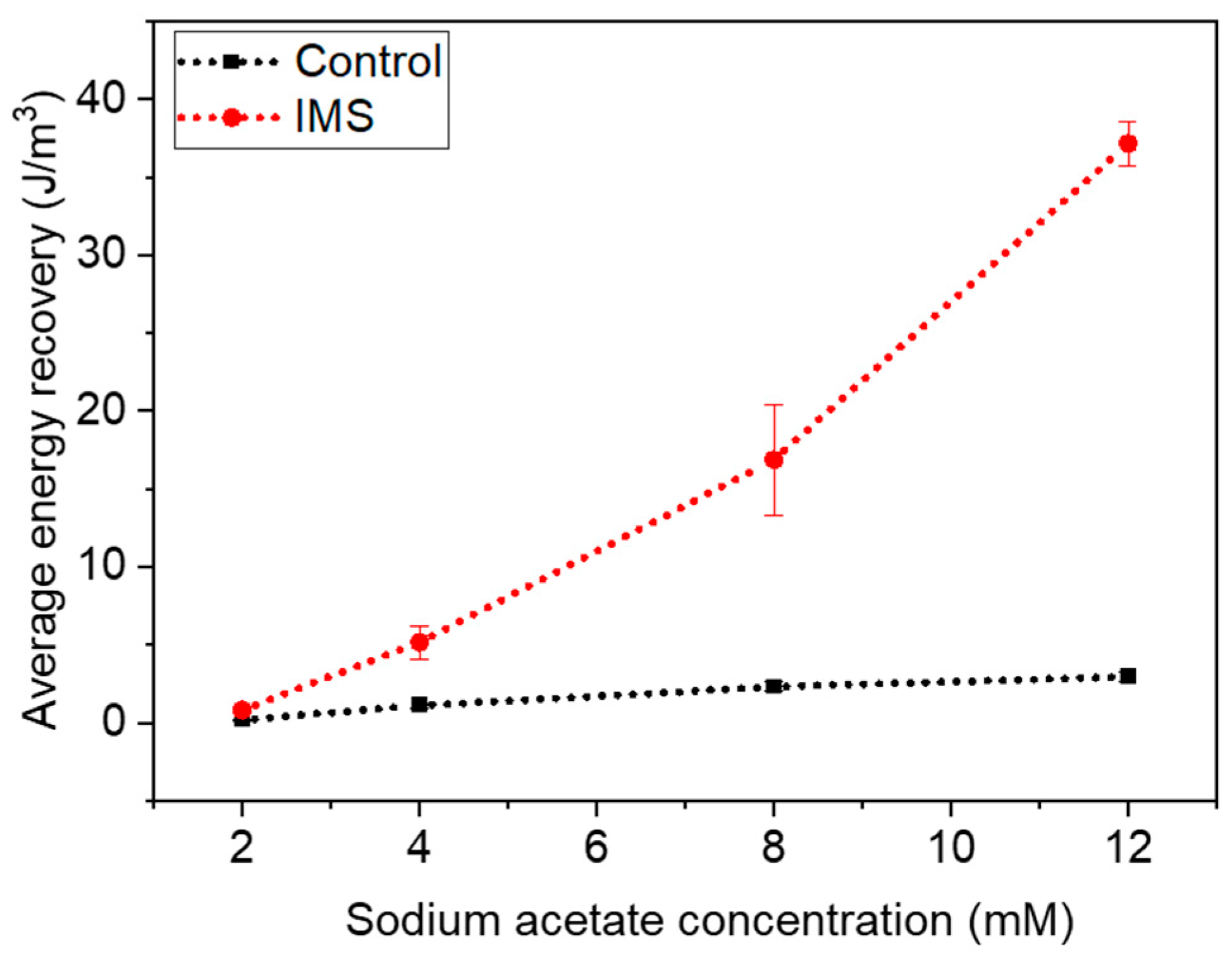
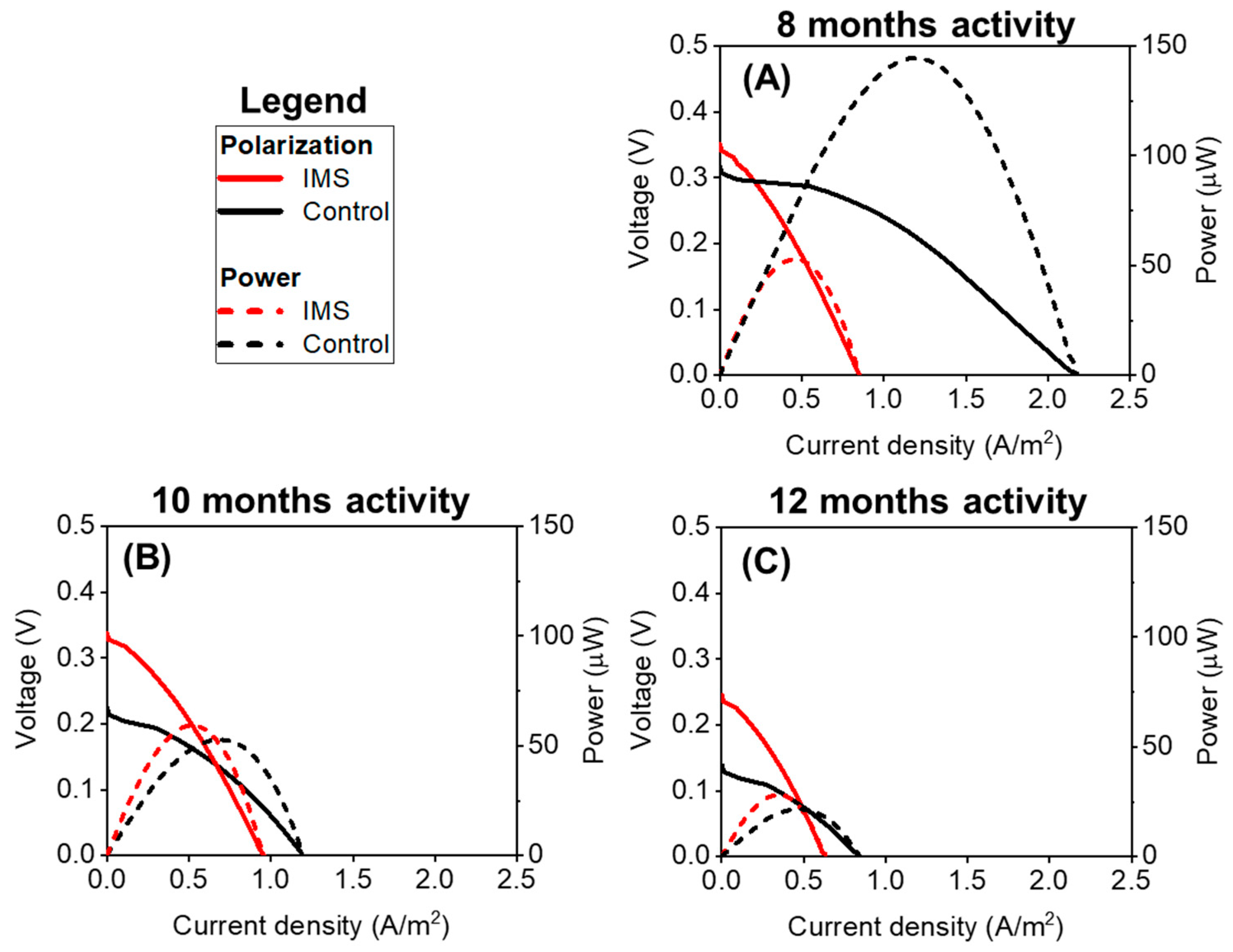
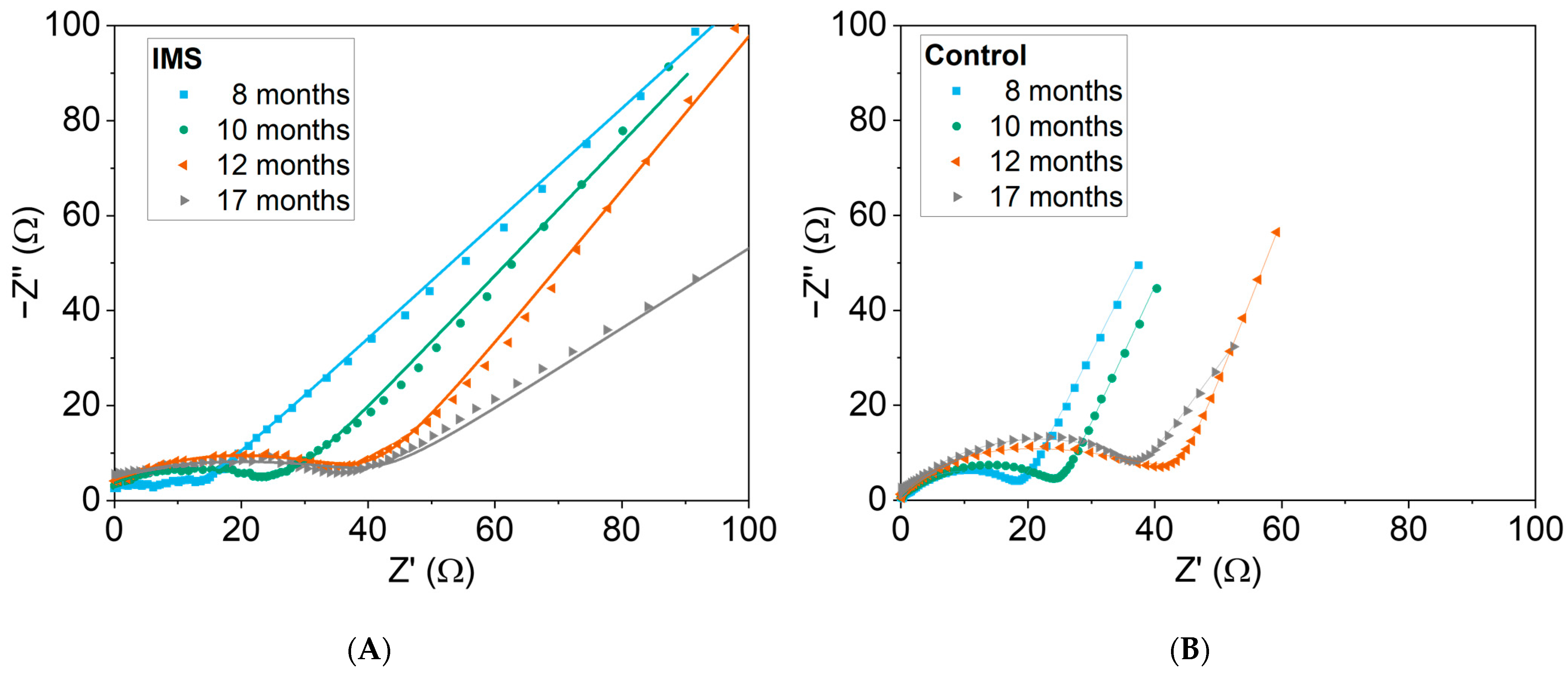
| MFC Designs | Performance Achieved | Ref. |
|---|---|---|
| Maximum output voltage: 0.59 V, reached after 4 cycles. | [48] |
| Maximum open-circuit voltage: 791 mV. | [49] |
| Maximum power density for both configurations was strictly correlated with the flow rate: the higher the flow rate, the higher the power density output. Drop-like architecture showed the largest power output. | [31] |
Disclaimer/Publisher’s Note: The statements, opinions and data contained in all publications are solely those of the individual author(s) and contributor(s) and not of MDPI and/or the editor(s). MDPI and/or the editor(s) disclaim responsibility for any injury to people or property resulting from any ideas, methods, instructions or products referred to in the content. |
© 2023 by the authors. Licensee MDPI, Basel, Switzerland. This article is an open access article distributed under the terms and conditions of the Creative Commons Attribution (CC BY) license (https://creativecommons.org/licenses/by/4.0/).
Share and Cite
Spisni, G.; Massaglia, G.; Bertana, V.; Vasile, N.; Pirri, F.C.; Bianco, S.; Quaglio, M. Novel Microfluidic Septum to Optimize Energy Recovery in Single-Chamber Microbial Fuel Cells. Appl. Sci. 2023, 13, 11423. https://doi.org/10.3390/app132011423
Spisni G, Massaglia G, Bertana V, Vasile N, Pirri FC, Bianco S, Quaglio M. Novel Microfluidic Septum to Optimize Energy Recovery in Single-Chamber Microbial Fuel Cells. Applied Sciences. 2023; 13(20):11423. https://doi.org/10.3390/app132011423
Chicago/Turabian StyleSpisni, Giacomo, Giulia Massaglia, Valentina Bertana, Nicolò Vasile, Fabrizio C. Pirri, Stefano Bianco, and Marzia Quaglio. 2023. "Novel Microfluidic Septum to Optimize Energy Recovery in Single-Chamber Microbial Fuel Cells" Applied Sciences 13, no. 20: 11423. https://doi.org/10.3390/app132011423








